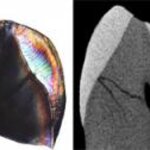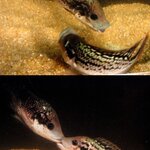Evolution

Countering a common theory that human evolution has slowed to a crawl or even stopped in modern humans, a new study examining data from an international genomics project describes the past 40,000 years as a time of supercharged evolutionary change, driven by exponential population growth and cultural shifts.
In a study published in the Dec. 10 issue of the Proceedings of the National Academy of Sciences (PNAS), a team led by UW-Madison anthropologist John Hawks estimates that positive selection just in the past 5,000 years alone — around the period of the Stone Age — has occurred at a rate…
"The conflict between maternal and fetus genes is one of the weirdest ideas in the modern theory of evolution."* According to evolutionary logic, the fetus "wants" to milk the mother for all it can get; the mother "wants" to restrict the fetus to what it needs to survive and save something for future offspring. The reason is that the fetus benefits from every bit of help the mother gives, while the mother's return on her investment diminishes with increasing investment, (i.e. ever greater investment won't necessarily increase her fitness).
One example of this struggle is the regulation of…

An international European research collaboration led by scientists at the Max Planck Institute for Evolutionary Anthropology reports evidence for a rapid developmental pattern in a 100,000 year old Belgian Neanderthal (Homo neanderthalensis). The Scladina juvenile, which appears to be developmentally similar to a 10-12 year old human, was estimated to be in fact about 8 years old at death, according to the new research.
The report, published in Proceedings of the National Academy of Sciences USA (online edition early December), details how the team used growth lines both inside and on the…

Life on Earth may have originated as the organic filling in a multilayer sandwich of mica sheets, according to Helen Hansma of the National Science Foundation and the University of California, Santa Barbara.
In a presentation at the American Society for Cell Biology’s 47th annual meeting, she proposes that the narrow, confined spaces between nonliving mica layers could have provided exactly the right conditions for the rise of the first biomolecules.
The “mica hypothesis” provides possible answers to many questions about life’s origins, according to Hansma. This layered mineral could have…

A team led by the University of Colorado at Boulder and the University of Milan has discovered some unexpected forms of liquid crystals of ultrashort DNA molecules immersed in water, providing a new scenario for a key step in the emergence of life on Earth.
CU-Boulder physics Professor Noel Clark said the team found that surprisingly short segments of DNA, life's molecular carrier of genetic information, could assemble into several distinct liquid crystal phases that "self-orient" parallel to one another and stack into columns when placed in a water solution. Life is widely believed to have…

A multi-national team of biologists has concluded that developmental evolution is deterministic and orderly, rather than random, based on a study of different species of roundworms. The findings are reported in the latest issue of the journal Current Biology.
The researchers were interested in how development evolves in organs which themselves do not change. To do so, they examined the vulva—the female's copulatory and egg-laying organ—in nearly 50 species of roundworms. Because the vulva does not significantly change across species, one might predict that there would be little variation in…

A gene has been found in male cichlid fish that evolved to lure female fish so that male cichlids can deposit sperm in the females mouths. A study in BMC Biology reveals that the gene is associated with egg-like markings on the fins of cichlid fishes and uncovers the evolutionary history of these markings, which are central to the success of the fishes' exotic oral mating behavior.
Walter Salzburger, Ingo Braasch and Axel Meyer reared 19 cichlid species at Konstanz University in Germany and identified a gene involved in producing yellow pigment cells in oval spots on the fishes' fins.…

What is the fundamental creative force behind life on Earth? It's a question that has vexed mankind for millennia, and thanks to theory and almost a year's worth of number-crunching on a supercomputer, Rice University physicist and bioengineer Michael Deem thinks he has the answer: A changing environment may organize the structure of genetic information itself.
Deem's research is available online and slated to appear next month in Physical Review Letters.
"Our results suggest that the beautiful, intricate and interrelated structures observed in nature may be the generic result of evolution in…

New work on fruit fly genomics suggests new ways to look at the much larger human genome, and gives insights into the role of adaptation in evolution.
In two recent papers, researchers led by David Begun and Charles Langley, professors of evolution and ecology at the UC Davis Center for Population Biology, compared the whole genomes of several individuals of the fly Drosophila simulans to close relatives D. melanogaster and D. yakuba.
The same approach could be extended to the much larger genomes of humans and our close relatives, Begun said, showing which changes in the genome are uniquely…

A theory explaining the evolution of giant rodents, miniature elephants, and even miniature humans on islands has been called into question by new research published today in Proceedings of the Royal Society B: Biological Sciences.
A new study refutes the ‘island rule’ which says that in island environments small mammals such as rodents tend to evolve to be larger, and large mammals such as elephants tend to evolve to be smaller, with the original size of the species being the key determining factor in these changes.
The new research findings suggest that the tendency to either evolve…